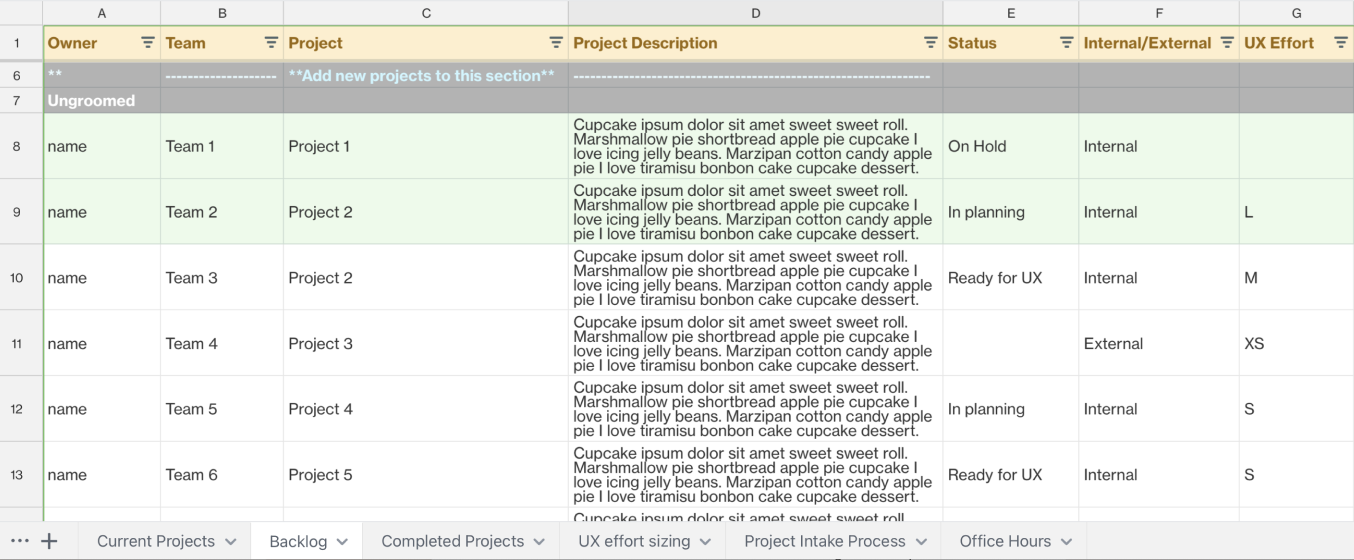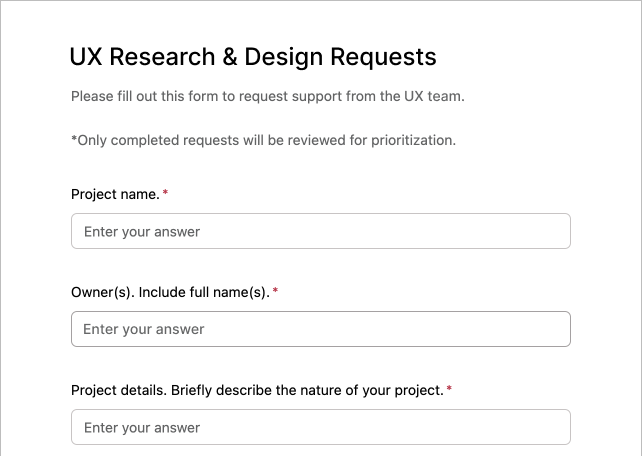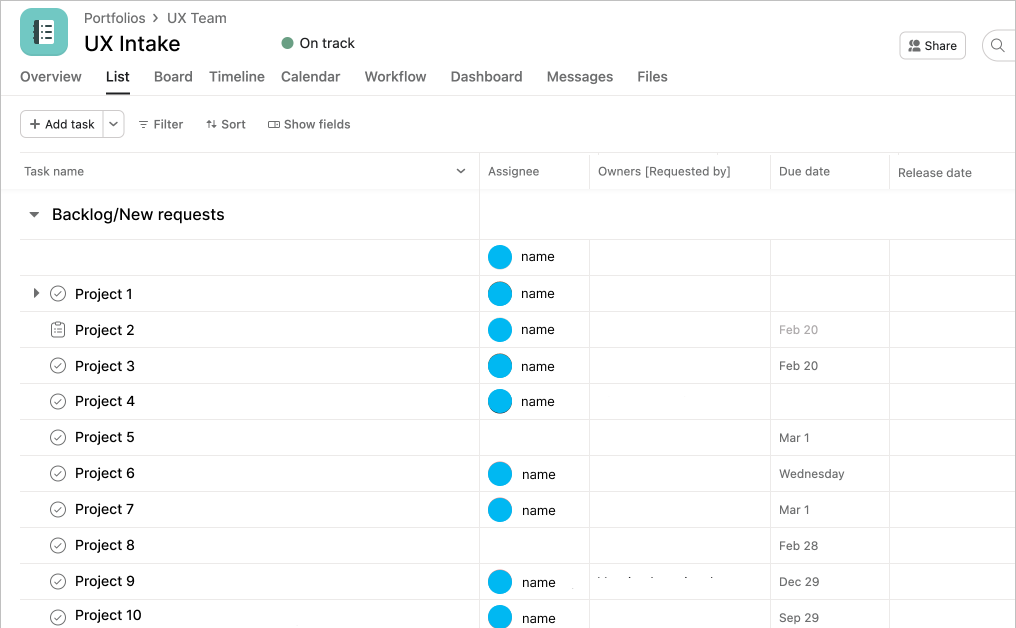I worked as part of a growing UX team, consisting of two designers, one researcher, and 30 product managers. The organization had 75 unique products, each with different purposes and functionalities. As the team expanded, it became clear that we needed to formalize our UX intake and tracking process to promote better planning, communication, and visibility across product teams.
Goals
- Streamline Intake and Prioritization: Establish a clear, consistent process for capturing, tracking, and prioritizing design and research requests
- Enhance Stakeholder Collaboration: Foster better communication and engagement between the UX team and product managers to align on project priorities.
- Improve Capacity and Roadmap Management: Better manage the UX team’s capacity while transitioning to a long-term roadmap for more strategic planning.

The Challenge
Adapting to a New Environment with a Fragmented UX Presence
Initial State: A Fragmented and Informal UX Process
When I joined, there was no established UX presence. Most teams hadn’t engaged with UX previously, and product managers were unsure how and when to involve UX in their projects. As the only designer, I had to navigate this ambiguity by building bridges with the product teams and introducing UX practices.

At the start, I managed all incoming requests through an informal system, using a simple spreadsheet tracker and monthly check-ins. However, this quickly became unsustainable as ad hoc requests flooded in, and the lack of clear prioritization prompted a need for constant communication. This is where the first iteration of our formalized process began.
What Was Working
- Visibility of Requests: The spreadsheet allowed us to track incoming projects, but the sheer volume made it difficult to ensure all stakeholders were aligned
- Bi-weekly Check-ins: These provided a valuable cadence for reprioritizing ongoing tasks and addressing urgent needs
- Office Hours gave us a dedicated time slot for small or ad hoc requests
What Needed to be Improved
- Clarifying UX Involvement: Product teams were still unsure about when and how to engage UX effectively
- Utilization of Office Hours: There was some confusion around how to best use this time, making it less effective
- Managing Changing Project Scopes: Frequent scope changes and carryovers meant that projects weren’t always delivered as expected
- Prioritization: While bi-weekly check-ins helped, a more structured system for prioritization was needed
Formalizing the UX Process
Intake Forms, Sprints, and Syncs
As the UX team grew, we realized we needed a more robust system. Working closely with my team, we designed a new, streamlined process that allowed for better tracking, clearer priorities, and more efficient collaboration.
#1 Intake Form: Standardizing Requests for Clarity and Consistency
We developed a standardized intake form for all design and research requests. Whether the requests were large, small, or ambiguous, this form helped provide clarity from the start and ensured that requests were entered into a single system for tracking. The questions in the form were informed by my previous spreadsheet, ensuring a smooth transition to this new method.

#2 Backlog and Tracker: Moving to Asana for Improved Tracking
I migrated all existing projects into Asana and directed new requests into the same tracker. This allowed the team to better manage incoming requests, making it easy for us to quickly respond. Every request received a response within 48 hours, either:
- An acknowledgment with an estimated timeline for when we’d engage, or
- An invitation to office hours for more details.

#3: Grooming and Pre-Sprint Syncs: Streamling Sprint Planning
Our bi-weekly check-ins evolved into structured two-week sprint cycles. To ensure alignment between product teams and the UX team, we introduced a Pre-Sprint Sync meeting. The goal of this meeting was to ensure that both parties understood the priorities and expectations for the upcoming sprint.
Sprint Sync: During this meeting, we discussed ongoing projects and ensured everyone was aligned on new priorities for the upcoming sprint.
Grooming Sessions: The day before the Pre-Sprint Sync, the UX team would hold a grooming session to review all incoming requests, understand the scope, and assign tasks accordingly.
Leading the Conversations: Prioritization and Stakeholder Alignment
As the facilitator of both the grooming sessions and Pre-Sprint Syncs, I played a crucial role in leading conversations around project priorities. During the syncs, I provided updates on ongoing projects, highlighted any carryovers from previous sprints, and allowed stakeholders to raise any concerns or additions to the backlog. This ensured everyone was aligned before we kicked off each sprint.
Continuing to improve
Capacity Tracking, Documentation, and Better Prioritization
While the system we implemented has led to significant improvements, we recognized that there are still areas to refine.
What Works
✔ Better Use of Office Hours: Stakeholders are more comfortable utilizing office hours to discuss smaller or unclear requests
✔ UX-Led Prioritization: We’ve established a clear process for prioritizing projects based on UX bandwidth, stakeholder needs, and business goals
✔ Improved Communication: Dedicated time to discuss upcoming projects had fostered stronger collaboration and clarity on expectations
What Needs Improvement
☐ Managing Long-Term Projects: Some design projects span multiple sprints, and tracking these long-term initiatives was a challenge
☐ Adapting to the Kanban vs. Agile Debate: Even with two-week sprint cycles, our process often resembles Kanban, with projects flowing in and out without strict adherence to agile methodology
☐ Capacity Tracking: We were still working on refining our system for tracking the team’s capacity, ensuring that no one is overburdened while maintaining flexibility
Lessons Learned
UX Roadmap
One of the most valuable lessons we’ve learned is that while agile processes are effective for ad hoc requests, they don’t fully replace the need for a dedicated UX roadmap. Our agile process worked for smaller requests, but a roadmap would allow us to prioritize work more effectively and better plan our team’s capacity.
We’re currently balancing both—using agile for shorter-term, unpredictable requests while developing a prioritized roadmap for the larger, long-term projects. This combined approach gives us the flexibility we need while ensuring that we can plan ahead for the most critical initiatives.
Evolving with the Team and Stakeholders
Our UX process has grown significantly since its early days, but we continue to evolve it to meet the needs of our rapidly changing environment. By formalizing our intake system, improving stakeholder communication, and ensuring consistent prioritization, we’ve established a process that allows us to deliver impactful design solutions while maintaining alignment across teams. Moving forward, we’ll continue to refine our roadmap and processes to provide even greater value to the organization.